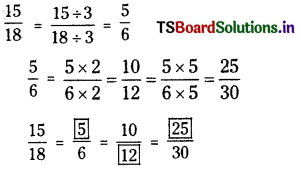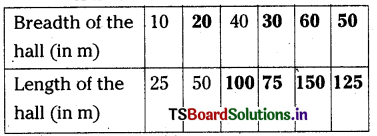Students can practice TS SCERT Class 6 Maths Solutions Chapter 11 Ratio and Proportion Ex 11.4 to get the best methods of solving problems.
TS 6th Class Maths Solutions Chapter 11 Ratio and Proportion Exercise 11.4
Question 1.
If three apples cost ₹ 45, how much would five apples cost ₹ *
Answer:
Cost of 3 apples = ₹ 45
Cost of each apple = ₹45 ÷ 3
= ₹ 15
∴ Cost of 5 apples = ₹ 15 × 5
= ₹ 75
![]()
Question 2.
Laxmi bought 7 books for a total of ₹ 56. How much would she pay for just 3 books ?
Answer:
Cost of 7 books = ₹ 56
Cost of one book = ₹ 56 ÷ 7 = ₹ 8
∴ Cost of 3 books = ₹ 8 × 3 = ₹ 24
Question 3.
Reena wants to prepare vegetable pulao, she needs 300 grams of rice, if she has to feed 4 people. How much of rice is needed if the same pulao is prepared for 7 people ?
Answer:
Quantity of rice required for the preparation of vegetable pulao for 4 people is 300 grams.
Quantity of rice needed to prepare pulao for 1 person = \(\frac{300}{4}\) = 75 grams
Quantity of rice needed to prepare pulao for 7 people = 75 × 7 grams = 525 grams
Question 4.
The cost of 16 chairs is ₹ 3600. Find the number of chairs that can be purchased for ₹ 4500.
Answer:
Cost of 16 chairs = ₹ 3600
Cost of one chair = \(\frac{3600}{16}\) = ₹ 225
Number of chairs that can purchased for ₹ 4500 = \(\frac{4500}{225}\)

Question 5.
A train moving at a constant speed covers a distance of 90 km in 2 hours. Find the time taken by the train to cover a distance of 540 km at the same speed.
Answer:
Time taken by the train to cover a distance of 90 km in 2 hours.
It covers 45 km in = \(\left(=\frac{90}{2}\right)\) 1 hour.
Time taken by the train to cover 540 km 540
= – \(\frac{540}{45}\) hours
= 12 hours
Question 6.
The income of Kumar for 3 months is ₹ 15,000. If his monthly income remains the same then,
(i) How much will he earn in 5 months ?
(ii) In how many months will he earn ₹ 95,000 ?
Answer:
The income of Kumar for 3 months is ₹ 15,000.
The income of Kumar for 1 month is = ₹ \(\frac{15,000}{3}\) = ₹ 5,000
Kumar earns ₹ 5000 in one month.
(i) The income of Kumar for 5 months = ₹ 5000 × 5 = ₹ 25,000
(ii) The time needed to earn ₹ 95,000
= \(\frac{95,000}{5,000}\) = 19 months
∴ In 1 year and 7 months, he will earn ₹ 95,000.
Question 7.
If the cost of 7 meters of cloth is ₹ 294, find the cost of 5 m of cloth.
Answer:
Cost of 7 meters of cloth = ₹ 294
Cost of 1 meter of cloth = ₹ \(\frac{294}{7}\) = ₹ 42
The cost of 5 meters of cloth = ₹ 42 × 5 = ₹ 210
![]()
Question 8.
A farmer has sheep and cows in the ratio 8:3.
(i) How many sheep has the farmer, if he has 180 cows ?
(ii) Find the ratio of the number of sheep to the total number of animals the farmer has.
(iii) Find the ratio of the total number of animals with the farmer to the number of cows with him.
Answer:
The ratio of sheep and cows is 8 : 3.
(i) Total number of parts = 8 + 3 = 11
Value of 3 parts = 180
Value of 1 part = \(\frac{180}{3}\) = 60
The number of sheep that the farmer has = 60 × 8 = 480
Total number of animals that the farmer has = 180 + 480 = 660
(ii) The ratio of the number of sheep to that of total animals = 480 : 660
= 8 : 11
(iii) The ratio of the number of animals to that of cows = 660 : 180 = 11:3
Question 9.
Are 3, 5, 15, 9 in proportion ? If we change their order, can we think of proportional pairs ? Write as many proportionality statements as you can for the above example ?
Answer:
3, 5, 15, 9 are the given numbers.
Ratio of 3 to 5 = 3 : 5
Ratio of 15 to 9 = 15 : 9 (i.e) 5 : 3
Since 3 : 5 5 : 3
3, 5, 15, 9 are not in proportion. .
We can think of proportional pairs if the order is changed.
3, 9, 5, 15 are in proportion.
5, 3, 15, 9 are in proportion.
3, 5, 9,15 are in proportion.
9, 3, 15, 5 are also in proportion.
Question 10.
The temperature has dropped by 15 degree Celsius in the last 30 days. If the rate of temperature drop remains the same, how much more will the temperature drop in the next 10 days ?
Answer:
In 30 days the temperature dropped by 15°, Celsius
In 1 day the temperature dropped by 150 \(\frac{15^{\circ}}{30}\) Celsius
In 10 days the temperature will drop 15 by \(\frac{15}{30}\) × 10 = 5° Celsius
Question 11.
Fill in the following blanks.

Answer:

![]()
Question 12.
(i) Ratio of breadth and length of a hall is 2:5. Complete the following table that shows some possible breadths and lengths of the hall.

Add 3 more of your choice.
(ii) Find the ratio of length to breadth of your classroom.
Answer:
(i) Ratio of breadth and length of a hall is 2 :5.

(ii) Length of our classroom = 5 m
Breadth of our classroom = 4 m
The ratio of length to breadth of our classroom = 5m : 4m = 5 : 4
Question 13.
Geetha earns ₹ 12,000 a month, out of which she saves ₹ 3,000. Find the ratio of her
(i) Expenditure to savings
(ii) Savings to her income
(iii) Expenditure to her income
Answer:
Earning of Geetha = ₹ 12,000 per month
Geetha’s saving = ₹ 3,000
Geetha’s expenditure
= ₹ 12,000 – ₹ 3000 = ₹ 9,000
(i) The ratio of Geetha’s expenditure to savings is 9000 : 3000 = 3:1
(ii) The ratio of Geetha’s savings to her income is 3000 :12000 = 1:4
(iii) The ratio of Geetha’s expenditure to her income is 9000 : 12000 = 3:4
Question 14.
There are 45 persons working in an office. The number of females is 25 and the remaining are males. Find the ratio of .
(i) The number of females to number of males.
(ii) The number of males to the number of females.
Answer:
The number of persons in the office . =45
The number of females = 25
The number of males = 45 – 25 = 20
(i) The ratio of the number of females to the number of males = 25 : 20 = 5 : 4
(ii) The ratio of number of males to the number of females = 20 : 25 = 4 : 5
Question 15.
A bag of sweets contain yellow and green sweets. For every 2 yellow sweets, there are 6 green sweets. Complete this table based on the above information.

Answer the following questions.
(i) What is the ratio of green to yellow sweets ?
(ii) If you have 8 yellow sweets, how many green sweets will you have ?
(iii) If there are 32 sweets in the medium sized bag. How many will be yellow ?
(iv) In the super fat size bag there are 40 sweets. How many will be green ?
(v) In a bag if there are 16 yellow sweets. How many total sweets are in the bag?
Answer:

(i) The ratio of green to yellow sweets is 6 : 2 (i.e.,) 3:1
(ii) For 2 yellow sweets, there are 6 green sweets. For 8 yellow sweets, there are \(\frac{6}{2}\) × 8 = 24
(iii) In a bag of 32 sweets, the number of yellow sweets = \(\frac{2}{8}\) × 32 = 8
(iv) In a bag of 40 sweets, the number of green sweets = \(\frac{6}{8}\) × 40 = 30
(v) For 16 yellow sweets, total sweets in the bag = \(\frac{8}{2}\) × 16 = 64
![]()
Question 16.
In a school survey it was found that for every 4 girls there were 5 boys. Fill In the following table.

Now answer these questions:
(i) What Is the ratio of girls to boys ?
(ii) In a class of 27 children, how many would be girls ?
(iii) There are 54 children In a class. How many are boys ?
(iv) If 20 girls join in a year. How many boys would join ?
Answer:
For every 4 girls, there were 5 boys.

(i) The ratio of girls to boys is 4 : 5
(ii) The number of girls in a class of 27 children is \(\frac{4}{9}\) × 27 = 12
(iii) The number of boys in a class of 54 students is \(\frac{5}{9}\) × 54 = 30
(iv) If 20 girls join in a year, the number of boys that would join is \(\frac{5}{4}\) × 20 = 25